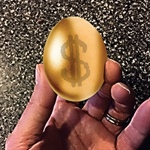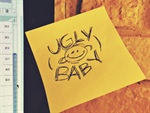
New article from Marshall Atkinson at atkinsontshirt.com. One of the greatest things about the decorated apparel industry is the diverse spectrum of customers that we can appeal to for our services. We literally can do anything for anybody. This is such a true fact that I think a lot of shops get lost when trying to figure out who they should be marketing to in their area.
I’ve asked plenty of shop owners this question: “What is your perfect order?” A good chunk of them will come back with the “Oh, we’ll take anything! We sell to everyone!”
Does that sound like you?
Monday, April 11, 2016/Author: Anonym/Number of views (1612)/Comments (0)/
Tags:

How your squeegee method can affect your print results
I visit hundreds of print shops a year - teaching, training and sharing. I also visit a few trade shows and distributors' open houses. One thing I see in the trade shows and open houses that I rarely see in professional print shops is printers who are pushing the squeegee instead of pulling.
Friday, April 8, 2016/Author: Anonym/Number of views (1642)/Comments (0)/
Tags:

Most screen printers are familiar with the flash-cure unit, and many shops use this piece of equipment as part of their production sequence. A flash-cure unit is used during production to cure the surface of the ink only, at least, that’s what it’s intended for.
It is important to understand the relationship between several factors that play a role in how well the flash cure gels the ink, and how to manipulate each to get the best results. Here’s what to watch out for when trying to set up the flash for optimal use:
Wednesday, April 6, 2016/Author: Anonym/Number of views (1599)/Comments (0)/
Tags:
Monday, April 4, 2016/Author: Anonym/Number of views (1641)/Comments (0)/
Tags:

It’s true what they say: a good screen print starts with a good screen. This seems simple, but high-quality screen creation is actually one of the more difficult processes to master. With variables like humidity, temperature, aging emulsion, and variations in exposure units, it’s important to really dial in the specifics of your screen making process before jumping into the deep end of screen burning. You can put block out and tape on a screen, trying to salvage it for an hour, but nothing beats a good screen done right the first time. Your customers will notice the difference, too. For the best results, make sure you take proper care with each step, and maybe even implement a few tricks along the way.
Friday, April 1, 2016/Author: Anonym/Number of views (1614)/Comments (0)/
Tags:

The M&R Companies release a video that showcases its newly streamlined parts department. Upgrades in the parts fulfillment department come as the latest development in major growth for the company,which includes anew headquarters in Roselle, Ill. in late 2015.
Wednesday, March 30, 2016/Author: Anonym/Number of views (1779)/Comments (0)/
Tags:

New article from Marshall Atkinson at atkinsontshirt.com. I was running the other day and about halfway through my route when a song came on my playlist that lifted my spirits immensely. “Get Rhythm” by Johnny Cash. Sure, it’s an old song. But sometimes I like to hear tunes that have a little grit and history. Plus I’m a big fan of the Man in Black. Not all singers have to shriek through a song like they have their testicles in a vice, right?
Listening to the lyrics of the song (below at the bottom of the article), it occurred to me then that not a lot of people that I encounter daily do things to make themselves feel good or change their position about something. Why is everyone always in a sour mood these days?
Being happy, makes other people happy too.
This can be crucial to your success, especially if you are in a position of leadership or management. Don’t think others notice that you are in a cranky mood? Don’t delude yourself.
A crappy mood is like luggage that you are carrying around with you all day. It is a unnecessary burden, and it affects everything you touch because unless you put down those bags, you aren’t going to handle things correctly. Everyone you bark at, insult, or growl instructions to just thinks you are a jerk…or worse.
Want to change your outlook and find your happy place so you can interact with others well? Here are a few ideas that could influence how you see things internally for the better:
Monday, March 28, 2016/Author: Anonym/Number of views (1491)/Comments (0)/
Tags:

With the choices of white inks in the market, it’s understandable that there is a lot of confusion as to which ink to use and what the differences are between each white.
Obviously, we cannot break down the differences of all the white inks on the market, but we’ve created a couple of tools to help differentiate the white inks that International Coatings manufactures.
The first is our updated Infographic (see image above), basically delineating which white ink to use for two main substrates – cotton vs. polyester.
The second tool is our White Comparison Chart, great for a quick reference, as it lists temperatures, and other ink characteristics.
Check both of them out
Friday, March 25, 2016/Author: Anonym/Number of views (1531)/Comments (0)/
Tags:

Quality screen printing of apparel begins with the garment itself. The garment impacts every other variable in the process, and understanding how it does so is central to achieving the best possible result. Stitch count, finish, weight, thickness, and fabric properties such as the potential for dye migration and heat sensitivity, as well as the material’s construction and color, all affect the print, and need to be considered in the production process. They may influence the mesh you choose for the job, the ink you select, the print/flash sequence, and much more; these factors, in turn, determine the quality level at which a specific piece of artwork can be reproduced on a particular garment.
Wednesday, March 23, 2016/Author: Anonym/Number of views (1578)/Comments (0)/
Tags:

New article from Marshall Atkinson at atkinsontshirt.com.
That’s right I said it. Bring the hate.
And by baby, I don’t mean your offspring. I mean your t-shirt design, embroidery idea or product plan for your new apparel line. Whew. Are you sure you are going with that?
This is something that nobody is going to tell you. Especially your apparel decorator.
Why you ask?
Well, basically they just want to produce the order and get the business. Even if it is only for that one time when you order. Because you know. Your baby is ugly. There won’t be a reorder…they just can somehow tell; but they are just too polite to tell you.
The standard mantra long used in this industry is “We don’t have to wear it.”
They might hint at the ugly baby a little bit. If you hear something that sounds like, “Have we told you what a great art department we have?” That’s a nudge in the right direction. Not that you are listening.
Monday, March 21, 2016/Author: Anonym/Number of views (1461)/Comments (0)/
Tags: